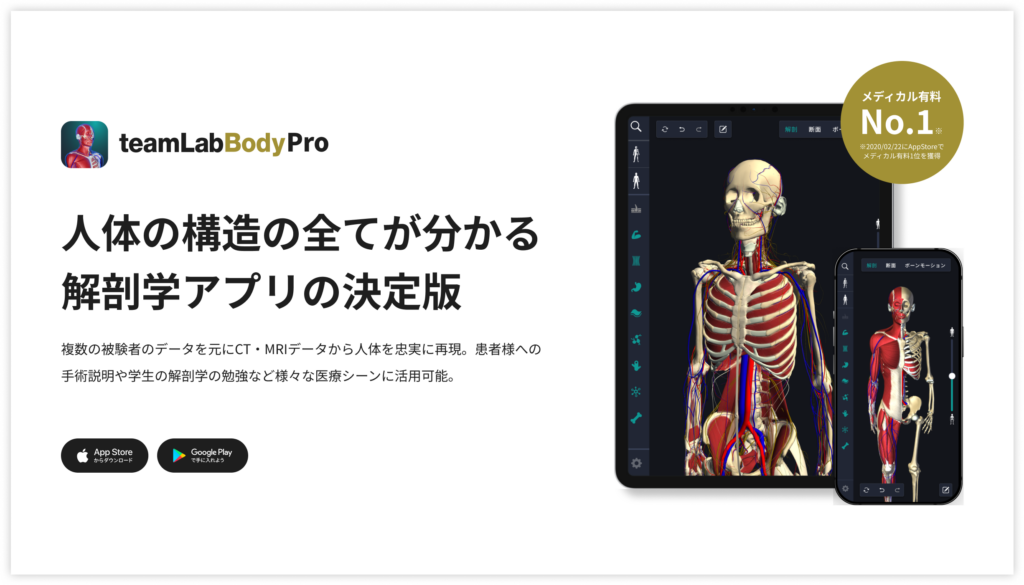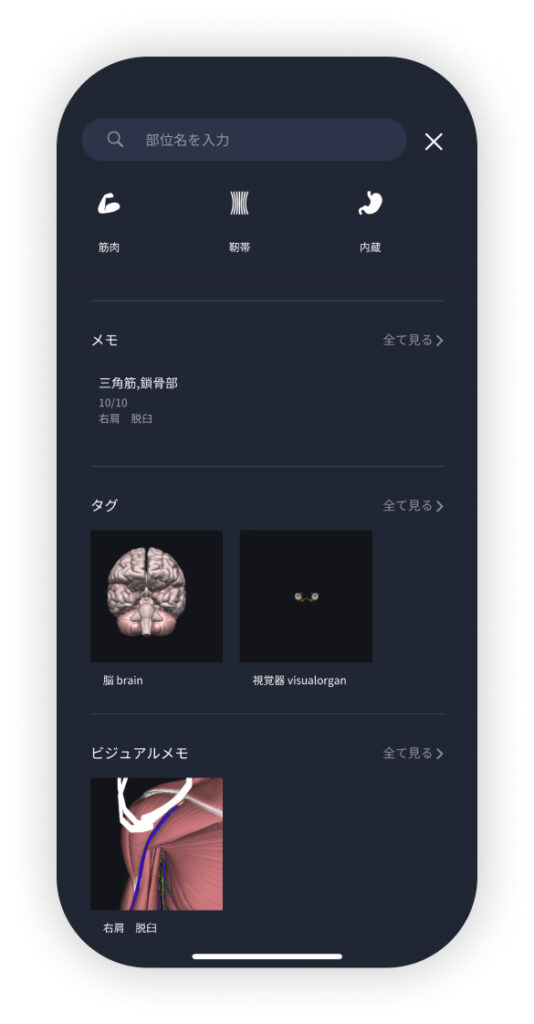beginning
In this article, I will explain effective study methods, starting with knowledge of specialized parts in human anatomy.
In human anatomy, it is necessary not only to memorize the names of various organs, muscles, and bones, but also to remember where they are located in the body. Therefore, it is necessary to learn as efficiently as possible.
I hope you will deepen your understanding even a little by reading this article and using the app.
Now, I'll explain the details about the “vestibular ligament” and how to study human anatomy.
teamLab Body Pro Free Download
A 3D anatomy app that shows all the structures of the human body
Download teamLab Body Pro here!

What is vestibular ligament?
The anatomy application allows you to view a selection of anatomy 3D models. In this model, there are various observation methods such as surfaces, cross-sections, and nervous systems. This time, I'll explain using an anatomy application.
About vestibular ligament

vestibular ligament(vestibular ligament) is a ligament that plays an important role in the larynx, is located at the top of the vocal cords, and is deeply involved in the formation of the glottis and voice regulation.
The vestibular ligament not only supports the structure of the vestibular chamber (upper part of the vocal cords) of the larynx, but also supports vocal cord vibrations when emitting speech. In order to generate speech, it is important to properly close the vocal cords, but the vestibular ligament reinforces this closing function and plays a role in maintaining the stability of the larynx during breathing and speech.
The vestibular ligament is connected to a cartilaginous structure called the epiglottis and is also involved in protecting the airways. These ligaments expand and contract during breathing and speech, and their elasticity provides the tension necessary for the vocal cords to function properly.
It is important for sound generation due to laryngeal vibrations, and when its proper function is lost, vocal cord vibration becomes incomplete, and speech impairment may occur.
Study points
Anatomical understanding: vestibular ligament location and structure
The vestibular ligament is located between the vocal cords and epiglottis and plays an important role during speech and breathing. The basic way to learn is to refer to a detailed anatomical diagram of the larynx and grasp its exact location and connection parts. Also, in order to understand how the vestibular ligament is arranged above the vocal cords and how it is involved in the overall function of the larynx, it is easier to visually understand its structure by using 3D applications and models.
Functional understanding: vocal cord movement and the role of vestibular ligament
In order to understand the role of the vestibular ligament, it is important to experience vocalization and breathing movements. When actually making a voice, being aware of how the vestibular ligament supports vocal cords and sound is generated is effective for deepening understanding the function of ligaments. In particular, when the cause of hoarseness is vestibular ligament dysfunction, learning specifically what effects it has is useful for clinical applications.
Practical application: clinical application of vocal cord disorders
The vestibular ligament is also deeply involved in conditions and treatments related to vocalization. For instance,vocal cord polypsandlarynx inflammationIf there is, it may affect the function of the vestibular ligament, so an anatomical understanding of it is necessary. At actual treatment sites, vocal cord abnormalities and disorders involving the vestibular ligament are evaluated, and it is useful when performing rehabilitation and vocal cord treatment. Clinically, rehabilitation and surgery may be performed based on knowledge about vocal cord movements and vibrations.
How to study human anatomy
I will explain specific study methods using human anatomy applications.
Check your past learning history and practice repeatedly
Here are the steps to check your anatomy learning history and practice iteratively effectively.
1. Check your learning history in the app
Reviewing your learning history with the application is an important step in effectively advancing anatomy learning. First, launch the app and go to the learning history section from the main menu. Many anatomy apps are designed to show your progress in the form of graphs and lists, so you can visually check which parts you've learned about and how much time you've spent.
By using this data, you can understand which areas you have strengths in and where you need to spend more time and effort. We also recommend using a dedicated tag or notebook function to mark areas you are particularly weak at or where you need to relearn. Regularly checking your learning history and looking back on past learning content will lead to efficient review and deepening understanding.
2.Make a plan for iterative learning
Making an efficient repetitive learning plan based on learning history is extremely effective in promoting knowledge retention. First, identify weak points and areas where you need to relearn. Next, arrange these study items into a weekly or monthly calendar and create a specific study schedule. By proceeding in a planned manner, you can learn each part evenly and avoid packing in a large amount of information at once.
Using a task management app or digital calendar to set study reminders is effective. Also, it's important to have the flexibility to regularly review progress and revise plans as needed. By having goals and proceeding with your studies in a planned manner, you can efficiently acquire anatomical knowledge.
3.Use 3D features to learn visually
By utilizing the 3D function, learning anatomy is easier to understand visually. The 3D model shows the structure of the human body three-dimensionally, and each part can be observed in detail. This makes it possible to intuitively grasp positional relationships between deep muscles and organs that are difficult to capture in a planar view. For example, you can learn even the smallest details by rotating specific muscles and bones and zooming in and out.
Also, there are many apps that have the function of displaying cross-sectional views of each part using a 3D model, which is useful for deepening understanding of internal structures. This diversity of visual information helps with memory retention and improves immediate responsiveness in tests and practice situations. By utilizing the 3D function and learning visually, you can learn anatomy knowledge more deeply and efficiently.
Use the memo function concretely

Make notes so you don't forget the things and points you've noticed while studying. The memo function can be used for different purposes, such as inputting text, saving images, and writing memos. Tag your notes to make them easier to review later.
Test your learning regularly in the form of quizzes
Regularly testing what you've learned in a quiz format is a very effective way to anchor your anatomy knowledge. Quiz-style tests help you objectively grasp your level of understanding and areas you lack while repeating knowledge.
For example, by using a learning app to conduct quizzes every specific period, you can reconfirm what you've learned and strengthen your memory. There are a wide range of quiz formats, such as multiple choice questions, fill-in-the-blank questions, and short answer questions, and each helps understanding from a different angle and develops the ability to utilize various types of knowledge.
Get feedback
If possible, get feedback from other learners and experts. It helps you find your own gaps in understanding and areas for improvement. You can also keep yourself motivated to learn by regularly testing yourself. Feeling a sense of accomplishment and progress increases motivation for continuous learning.
summary
This time, I explained how to study about the “vestibular ligament” using an application!
Thank you for reading this far.
I would be happy if reading this article helped you learn about anatomy.
Learning is a long, never-ending journey, but I sincerely wish you all the best. Let's continue to study together and work hard for the national exam!
Please look forward to the next blog.
teamLab Body Pro Free Download
A 3D anatomy app that shows all the structures of the human body
Download teamLab Body Pro here!





